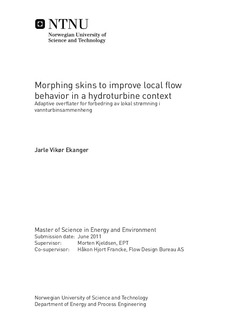Morphing skins to improve local flow behavior in a hydroturbine context: Adaptive overflater for forbedring av lokal strømning i vannturbinsammenheng
Master thesis
Permanent lenke
http://hdl.handle.net/11250/234337Utgivelsesdato
2011Metadata
Vis full innførselSamlinger
Sammendrag
This thesis deals with the application of morphing skin and structure technology in a hydroturbine context. The work has been divided into two parts; construction of a demonstration rig and CFD calculations assessing the concept of camber morphing of guide vanes.Five rubber 'morphing bumps' reduce the intensity of vortex shedding behind a cylinder in an open flow of water. The bumps are made by a rubber bellows placed in a perforated stainless steel pipe. Their size is controlled by air pressure, and the option of reducing them to a neutral state is present. A control software has been designed using Labview, allowing manual and automatic (model predicted flow control) operation, as well as logging of measurements. The tests show that the bumps are capable of reducing vortex intensity by approximately 25%.CFD simulations has been performed on a Francis turbine section to determine if altering the camber of guide vanes at different loads can have a beneficial effect to the performance and wear characteristics. The simulations resulted in a dataset consisting of steady state and transient simulation results from 28 combinations of camber and wicket gate opening. The results did not establish that camber morphing can increase efficiency, but neither did they reject it completely. It has been shown that for small cambers up to 2%, the gains from increased lift far outweigh increased drag at part loads.
